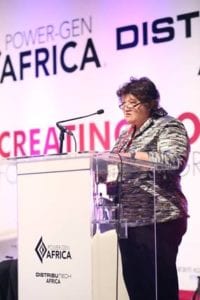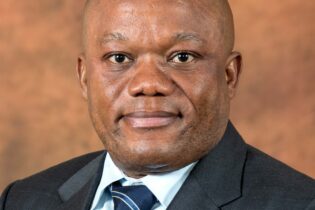
Minister of Public Enterprises Lynn Brown addressed delegates at POWER-GEN & DistribuTECH Africa 2016
During the opening session of the fourth annual POWER-GEN & DistribuTECH Africa, keynote speakers noted that Africa had the greatest concentration of households without electricity in the world; with 10 African countries having over 75% of their populations unconnected to power. Lynne Brown, South African Minister of Public Enterprises, said: “The
current electricity deficit in Africa is quite alarming. This lack of electricity access remains one of the biggest barriers to development and prosperity and continues to trap millions of people in poverty.” In her opening address, the Minister noted that the use of renewable energy sources was increasing, but said that the early stages of South Africa’s Independent Power Producer programme had highlighted constraints in alignment of the national grid to new renewable energy sources. Major investment would be required in the transmission grids to ensure renewables delivered on their potential, she said. Brown noted that while South Africa’s power supply and demand side management had remained stable over most of the past year, surging demand and ageing infrastructure meant there was pressure on the government to consider power generation technologies that could meet future demand affordably and with a low carbon footprint. The government was looking to a mix of coal-fired, nuclear, natural gas and hydro power, supplemented by renewables such as wind and solar, she said. “However, for baseload generation, there are still only two real options – coal and nuclear. Future development requires assessments of COP 21 guidelines and overall lifecycle costs. There is growing consensus that future cost comparisons will favour nuclear over fossil. However, more research is required,” she said. In line with this, the minister announced that as part of the
second phase of the Eskom Power Plant Engineering Institute (EPPEI) programme, Eskom would establish a specialisation centre focusing on nuclear technology. Also speaking at this morning’s opening session, Nigel Blackaby, Director of Conferences at event organisers PennWell International Power Group, noted: “The energy industry is undergoing a period of major change that stakeholders have to respond to. The sector is awash with so-called disruptive technologies, the rise of renewables, the emergence of smart grids, decentralised generation and smarter storage technology. It’s a heady cocktail, but it’s also a very exciting one, opening up all sorts of possibilities.”
Blackaby cited a recent McKinsey report finding that globally, the proportion of people with no access to power would fall from 30% to 17% by 2040, but that in Africa this trend would be reversed, with the percentage of people without power expected to grow from 49% to 75%.
“There is no one solution to solve all of Africa’s power challenges, but through a combination of power and distribution technologies, and regional collaboration within power pools, great strides could be made to meet future demand,” he said. William Price, Country Manager at Enel Green Power South Africa, noted that a changing environment demanded creative and innovative approaches to power generation and distribution. “Africa has an abundance of renewable resources available, but availability is not the only consideration,” he said. “Political stability, appropriate regulatory environments and government support for public private partnership structures are also factors investors consider,” he noted. “We need to focus on how we use renewable and smart technologies and make the consumer the centre of the energy value chain.” George Njenga, Regional Executive at GE Steam Power Systems, Sub-Sahara Africa said: “Africa’s resource irony is we have abundant oil and gas, sunshine, wind and vast coal reserves, yet Africa is still power starved.” “The challenge is urgent,” he said. “We need to work together to bring about the change the continent needs.” Nejnga said smarter, more advanced technologies should be deployed to maximize the value of existing infrastructure. For example, he noted that advanced steam power generation technologies would allow coal plants to optimise their outputs and reduce harmful emissions.







